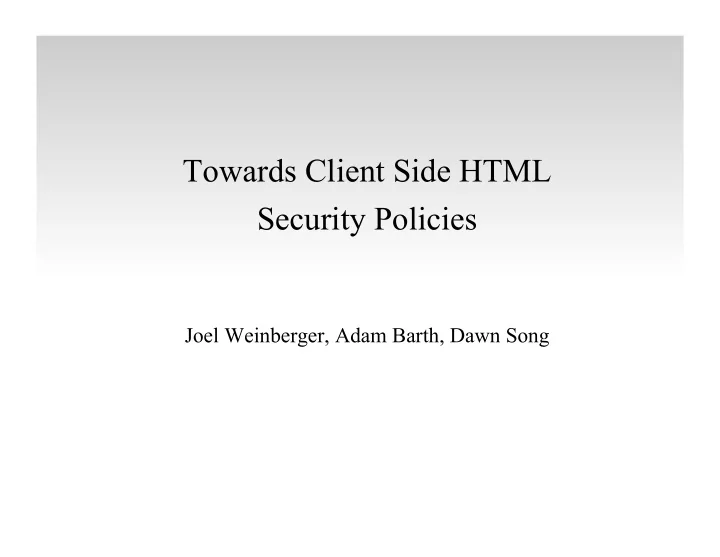

Towards Client Side HTML Security Policies Joel Weinberger, Adam Barth, Dawn Song
MySpace
Samy Worm
Content Injection The insertion of untrusted data, structure, or code into an application
Key Points • Explicit policies form a compelling, unique point in the content injection protection design space • The current trade-offs in explicit policy systems make none of the current systems completely viable • Explicit policies are the way forward, but we need new system designs
Content Injection <html> <h1>Forum Post #1</h1> <div> This is the content of the post. </div> </html>
Content Injection <html> <h1>Forum Post #1</h1> <div> <script>alert(document.cookie);</script> </div> </html>
Policies Trusted <html> Trusted <h1>Forum Post #1</h1> Trusted <div> Untrusted <script>alert(document.cookie);</script> </div> </html>
Web Application Frameworks Systems for writing web applications Frameworks provide tools for sanitizing content Turns out, sanitization is hard Shameless plug for our ESORICS 2011 paper: A Systematic Analysis of XSS Sanitization in Web Application Frameworks
Implicit Policies Web Application Browser Policy
Explicit Policies Web Application Browser Policy
Key Points Explicit policies form a compelling, unique point in the content injection protection design space • The current trade-offs in explicit policy systems make none of the current systems completely viable • Explicit policies are the way forward, but we need new system designs
Explicit Policy Systems • BEEP • BLUEPRINT • Content Security Policy (CSP)
BEEP • Hashes of allowed scripts • Performance: good • Dynamic scripts are very hard to get right • Only XSS
BLUEPRINT • Structural description of page, enforced by JavaScript library • Performance: poor • Does not trust the browser’s parser • Very fine grained granularity
Content Security Policy (CSP) • Specify allowed behaviors of page • Performance: ? • Only handles some content injection • Coarse grained • What is the affect on how applications are written?
Applying CSP to Applications • How does CSP affect Web applications? • Apply CSP to Bugzilla and HotCRP • Measure performance of applications and how the applications were changed
CSP Study • Developer effort to retrofit applications to be CSP compatible is large • Template variables cannot be used in scripts • Need to lookup data through JavaScript • Template logic no longer affects scripts
CSP Study Bugzilla Page No Inline JS Async JS index.cgi 14.8% -3.0% editsettings.cgi 6.3% 5.1% enter_bug.cgi 57.6% 44.2% show_bug.cgi 51.5% 4.0% HotCRP Page No Inline JS Async JS index.php 45.3% 37.2% search.php 52.9% 50.4% settings.php 23.3% 16.1% paper.php 61.1% 58.5% contacts.php 67.8% 35.5%
Key Points Explicit policies form a compelling, unique point in the content injection protection design space The current trade-offs in explicit policy systems make none of the current systems completely viable • Explicit policies are the way forward, but we need new system designs
Explicit Policies: The Good and the Bad • Provide a separation policy from application • Not doing this makes security hard • Simple or complex: you choose • Not good at performance and developer usability
Towards the Future • Policy systems are useful and should be how we approach content injection • CSP has some great properties, but suffers when applied to current applications • How can we combine features from these different systems?
Key Points Explicit policies form a compelling, unique point in the content injection protection design space The current trade-offs in explicit policy systems make none of the current systems completely viable Explicit policies are the way forward, but we need new system designs
Recommend
More recommend